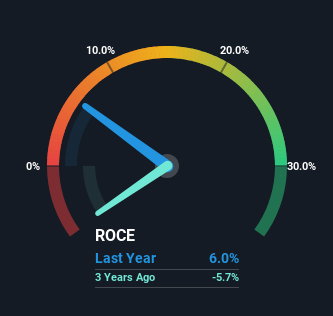Investors Will Want YLI Holdings Berhad's (KLSE:YLI) Growth In ROCE To Persist

What trends should we look for it we want to identify stocks that can multiply in value over the long term? Typically, we'll want to notice a trend of growing return on capital employed (ROCE) and alongside that, an expanding base of capital employed. Basically this means that a company has profitable initiatives that it can continue to reinvest in, which is a trait of a compounding machine. So on that note, YLI Holdings Berhad (KLSE:YLI) looks quite promising in regards to its trends of return on capital.
What Is Return On Capital Employed (ROCE)?
For those that aren't sure what ROCE is, it measures the amount of pre-tax profits a company can generate from the capital employed in its business. Analysts use this formula to calculate it for YLI Holdings Berhad:
Return on Capital Employed = Earnings Before Interest and Tax (EBIT) ÷ (Total Assets - Current Liabilities)
0.06 = RM6.2m ÷ (RM183m - RM80m) (Based on the trailing twelve months to June 2023).
Therefore, YLI Holdings Berhad has an ROCE of 6.0%. Ultimately, that's a low return and it under-performs the Building industry average of 8.7%.
Check out our latest analysis for YLI Holdings Berhad

While the past is not representative of the future, it can be helpful to know how a company has performed historically, which is why we have this chart above. If you'd like to look at how YLI Holdings Berhad has performed in the past in other metrics, you can view this free graph of past earnings, revenue and cash flow.
What Can We Tell From YLI Holdings Berhad's ROCE Trend?
It's great to see that YLI Holdings Berhad has started to generate some pre-tax earnings from prior investments. While the business is profitable now, it used to be incurring losses on invested capital five years ago. At first glance, it seems the business is getting more proficient at generating returns, because over the same period, the amount of capital employed has reduced by 30%. The reduction could indicate that the company is selling some assets, and considering returns are up, they appear to be selling the right ones.
Another thing to note, YLI Holdings Berhad has a high ratio of current liabilities to total assets of 44%. This can bring about some risks because the company is basically operating with a rather large reliance on its suppliers or other sorts of short-term creditors. While it's not necessarily a bad thing, it can be beneficial if this ratio is lower.
Our Take On YLI Holdings Berhad's ROCE
In summary, it's great to see that YLI Holdings Berhad has been able to turn things around and earn higher returns on lower amounts of capital. Investors may not be impressed by the favorable underlying trends yet because over the last five years the stock has only returned 40% to shareholders. Given that, we'd look further into this stock in case it has more traits that could make it multiply in the long term.
On a final note, we found 2 warning signs for YLI Holdings Berhad (1 makes us a bit uncomfortable) you should be aware of.
For those who like to invest in solid companies, check out this free list of companies with solid balance sheets and high returns on equity.
If you're looking to trade YLI Holdings Berhad, open an account with the lowest-cost platform trusted by professionals, Interactive Brokers.
With clients in over 200 countries and territories, and access to 160 markets, IBKR lets you trade stocks, options, futures, forex, bonds and funds from a single integrated account.
Enjoy no hidden fees, no account minimums, and FX conversion rates as low as 0.03%, far better than what most brokers offer.
Sponsored ContentNew: Manage All Your Stock Portfolios in One Place
We've created the ultimate portfolio companion for stock investors, and it's free.
• Connect an unlimited number of Portfolios and see your total in one currency
• Be alerted to new Warning Signs or Risks via email or mobile
• Track the Fair Value of your stocks
Have feedback on this article? Concerned about the content? Get in touch with us directly. Alternatively, email editorial-team (at) simplywallst.com.
This article by Simply Wall St is general in nature. We provide commentary based on historical data and analyst forecasts only using an unbiased methodology and our articles are not intended to be financial advice. It does not constitute a recommendation to buy or sell any stock, and does not take account of your objectives, or your financial situation. We aim to bring you long-term focused analysis driven by fundamental data. Note that our analysis may not factor in the latest price-sensitive company announcements or qualitative material. Simply Wall St has no position in any stocks mentioned.
About KLSE:YLI
YLI Holdings Berhad
An investment holding company, manufactures and trades in ductile iron pipes, steel and plastic pipes and fittings, and waterworks related products for the sewerage and waterworks industries in Malaysia, Singapore, and Vietnam.
Adequate balance sheet and slightly overvalued.
Market Insights
Community Narratives




